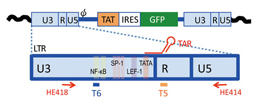Research Abstract
CRISPR/Cas9システムを用いて潜在性HIVプロウイルスを破壊する
Harnessing the CRISPR/Cas9 system to disrupt latent HIV-1 provirus
2013年8月26日 Scientific Reports 3 : 2510 doi: 10.1038/srep02510

抗レトロウイルス剤併用治療によって、生体内のHIV-1の複製を制御できるとはいえ、ウイルスは宿主ゲノムにプロウイルスとして潜伏化し(潜在保有と呼ばれる)、常に再発の恐れがある。しかし、HIV-1プロウイルスの破壊を目的とした新技術により、感染者からウイルスを根絶できるかもしれない。本研究では、CRISPR/Cas9システムによってHIV-1プロウイルスを編集し、その発現を抑制できる可能性を示す。末端反復配列(LTR)を標的としたCRISPR/Cas9構成分子を、HIV-1 LTRの発現が潜伏状態かつ誘導可能なT細胞に導入したところ、誘導後もLTR依存性発現の著しい消失が見られた。塩基配列解析により、CRISPR/Cas9システムは効率的にLTR標的部位を切断し、変異導入していることが確かめられた。さらに重要な点は、このシステムはウイルス遺伝子を宿主細胞の染色体から除去することも可能であることである。我々の結果は、CRISPR/Cas9システムがHIV-1感染症の治癒に有用なツールである可能性を示している。
蝦名 博貴1, 三沢 尚子1, 金村 優香1 & 小柳 義夫1
- 京都大学 ウイルス研究所 ウイルス病態研究領域
Even though highly active anti-retroviral therapy is able to keep HIV-1 replication under control, the virus can lie in a dormant state within the host genome, known as a latent reservoir, and poses a threat to re-emerge at any time. However, novel technologies aimed at disrupting HIV-1 provirus may be capable of eradicating viral genomes from infected individuals. In this study, we showed the potential of the CRISPR/Cas9 system to edit the HIV-1 genome and block its expression. When LTR-targeting CRISPR/Cas9 components were transfected into HIV-1 LTR expression-dormant and -inducible T cells, a significant loss of LTR-driven expression was observed after stimulation. Sequence analysis confirmed that this CRISPR/Cas9 system efficiently cleaved and mutated LTR target sites. More importantly, this system was also able to remove internal viral genes from the host cell chromosome. Our results suggest that the CRISPR/Cas9 system may be a useful tool for curing HIV-1 infection.

